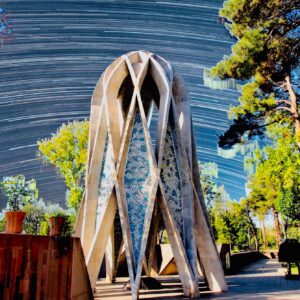Omar Khayyam's Startrail
Description
A photo composite of a timelapse sequence. From the photographer: “Hakim Omar Khayyam Neishaburi was a prominent Iranian philosopher, mathematician, and poet in the late 5th and early 6th century AH. He was a follower of Abu Ali Sina and contributed to the creation of the Jalali calendar. Khayyam also wrote a treatise on astronomical calculations. His poems, primarily in Persian and Tazi, focused on doubt, astonishment, death, and a reminder to take human life for granted.
Khayyam’s tomb, which was not independent until 1335, was designed and constructed by engineer Hoshang Sihun. The building features 10 bases, with the number 10 representing mathematical knowledge. The collision of the blades creates tangled stars, a five-pointed star, and ten large rhombuses, decorated with mosaic tiles, all referring to Khayyam’s personality. The complex was built in a poetic mood, with stout trees surrounding it and Khayyam’s grave blooming in the spring. The complex was designed to reflect Khayyam’s life and knowledge, and his tomb is now open for photography at night.
The good mood I had from being in Khayam’s tomb was just by sitting in different places and watching the visitors. Several hours passed, now it was time to place the cameras. I found their location for photography at night. I had less peace at night, with the coordination of Khayyam’s tomb complex, the lights of the area and other lights were turned off, but unfortunately, the strong lights that shined from outside, created many sharp and unwanted shadows. Anyway, I started taking pictures and the cameras were working. A bird constantly flying and calling, felt uneasy about my presence and stayed with me until the end of the work. Hours under the night sky and lying in Bagh Khayam were enjoyable, hoping that the final photos will be good.”


comments (0)